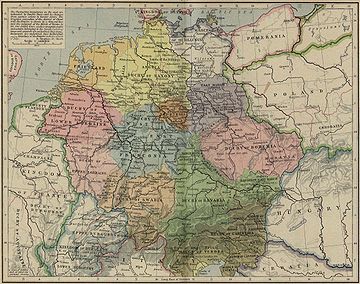- March of Styria
-
 Holy Roman Empire about 1000: Carinthia shown in brown with the marches of Verona, Istria, Carniola and Styria, according to William Robert Shepherd, 1923
Holy Roman Empire about 1000: Carinthia shown in brown with the marches of Verona, Istria, Carniola and Styria, according to William Robert Shepherd, 1923
The March of Styria (German: Steiermark) was originally broken off the Duchy of Carinthia before 970 as a buffer zone against the Magyars.[1] Originally it was known as the Carantanian march (marchia Carantana), after the former Slavic principality of Carantania, a predecessor of the Carinthian duchy. During the 11th century it evolved to be called Styria, so named for the town of Steyr, then the residence of the margraves.
The area was formerly part of the larger March of Carinthia, itself a frontier march of the Duchy of Bavaria. In 976 Emperor Otto II separated Carinthia from the Bavarian stem duchy and raised it to the status of a duchy in its own right. The adjacent territory in the east up to the Mur, Mürz and Enns rivers, that had been annexed by King Otto I after the 955 Battle of Lechfeld, was similarly converted into the marchia Carantana of the new Carinthian duchy.
The first margraves of Styria appear in the early 11th century. The dynasty ruling from 1056 was called the Otakars. Margrave Leopold the Strong (1122–1129) and his son Ottokar III (1129–1164) acquired large territories along the Savinja river down to the Windic March and moved their residence to Graz. In 1180, the march was converted into the Duchy of Styria.
Margraves of Styria
- Markward of Eppenstein (until c. 1000)
- Adalbero of Eppenstein (c. 1000-1035), son, also Duke of Carinthia and Margrave of Verona 1011-1035, deposed
- Arnold of Wels-Lambach (1035–1055)
- Godfrey of Pitten (1042–1050), son, co-margrave, assassinated
- Ottokar I (1055–1064), Count in the Chiemgau
- Adalbero (1064–1086), son, assassinated
- Ottokar II (1086–1122), brother of Adalbero
- Leopold the Strong (1122–1129), son of Ottokar II
- Ottokar III (1129–1164), son
- Ottokar IV (1164–1180), son, first Duke of Styria until 1192
Sources
- Semple, Ellen Churchill. "The Barrier Boundary of the Mediterranean Basin and Its Northern Breaches as Factors in History." Annals of the Association of American Geographers, Vol. 5. (1915), pp 27–59.
- Thompson, James Westfall. Feudal Germany, Volume II. New York: Frederick Ungar Publishing Co., 1928.
Notes
- ^ Thompson, 600.
Categories:- States of the Holy Roman Empire
- History of Austria
- 1180 disestablishments
- Styria
- States and territories established in 1035
- History of Slovenia
- German history stubs
Wikimedia Foundation. 2010.
